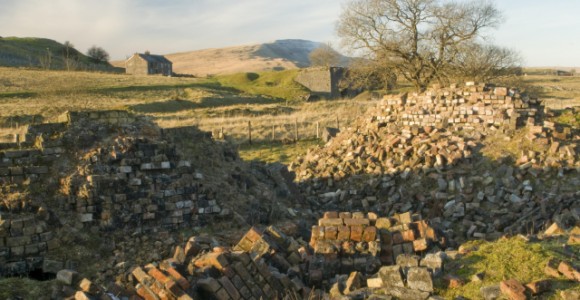The remains of the post-medieval and industrial periods that survive within the Bannau Brycheiniog National Park are visible for all see, from deserted settlements and abandoned farmsteads, rabbit farms and sheepfolds, to the quarries, kilns, canals and tramroads. These remains of our more recent past are numerous and perhaps speak more loudly to us than more ancient remains. Find out more about the post-medieval Bannau Brycheiniog and its role in the industrial revolution below.
Post-Medieval
Seasonal use of the uplands for summer pasture continued into the post-medieval period, and numerous remains of farms, small settlements and their associated field systems and enclosures survive within the Bannau Brycheiniog National Park, such as Y Graig near Gilwern the remains of a post-medieval settlement. The population across the post-medieval period led to a growing demand for meat and wool, and witnessed the growth of the importance of sheep farming, only increased by rapid industrial development and growth of the urban populations of South Wales. The upland areas of the Bannau Brycheiniog National Park became increasingly important for sheep farming, and the many drystone shelters, folds and shepherds’ huts built during this period still survive in the uplands today.
Another relatively common post medieval archaeological feature within the Brecon Beacons National Park are pillow mounds. These are flat topped earth mounds, often cigar shaped, with a series of internal stone lined tunnels, which were constructed as warrens for breeding rabbits. Unlike today, rabbits were a very rare occurrence in the countryside for much of history, and demand for their meat and fur saw the breeding of rabbits develop across the period. In parts of the Bannau Brycheiniog National Park, such as on the Black Mountain, rabbit farms like Cefn Cûl were created, where the number of pillow mounds and the large areas devoted to rabbit farming suggest large scale commercial operations. It may be that rabbit farming proved to be a profitable way to exploit marginal land.
Industrial
The Bannau Brycheiniog National Park lies to the north of the industrial heartland of the South Wales valleys, but many of the natural resources of this heavily industrialised area extend into the National Park, including iron ore, coal, silica and limestone, and the effects of the Industrial Revolution on the landscape of Bannau Brycheiniog National Park are profound in places with surviving remains relating to the milling and processing of wool, quarrying and mineral extraction, the lime industry, ironmaking and the manufacture of fire bricks, paper and gunpowder.
The landscape of the Bannau Brycheiniog National Park is dotted with old quarries that were worked to extract raw materials such as limestone, ironstone, tilestone and silica sand. A large complex of both limestone and silica sand quarries survive on the Black Mountain in the west of the National Park, and a survey of the uplands of the Black Mountains in the east of the National Park by Clwyd-Powys Archaeological Trust in 1998 identified over 120 quarry sites within this one part of the National Park alone. The quarries within the Brecon Beacons National Park are small scale and were used locally to provide raw materials for agriculture and buildings, others are much larger and were exploited commercially.
Limestone was a vital raw material in the industrial period; it was burnt in limekilns to produce quicklime, which was then used in the production of lime-mortar for buildings and in agriculture to spread on the fields and produce lime wash. Many examples of limekilns survive across the National Park, with particularly good examples at Penwyllt, Llanelli Hill and many examples along the Monmouthshire and Brecon Canal. Limestone was also used in the ironmaking process, and limestone quarries within the Bannau Brycheiniog National Park supplied ironworks in Blaenavon, Nantyglo, Hirwaun and in the Swansea Valley in the late 18th and 19th centuries.
None of the industries that thrived within the Bannau Brycheiniog National Park could have developed or survived without the turnpike roads, railways, tramroads and canals that linked these remote and marginal areas to local towns, the markets of industrial South Wales and the wider world. Large sections of the Brecon Forest Tramroad, an extensive network of early railways on which waggons were pulled by teams on men and horses, still survive today in the uplands of the Great Forest and Cefn Cribarth. The Brecon Forest Tramroad connected industry across a large part of the National Park, from Sennybridge in the north to Ystradgynlais in the south; its construction was such a large undertaking that it bankrupted the ambitious tramroad builder, wealthy London merchant John Christie. Turnpike roads were built across the National Park in the 18th century. They were important in the opening up and exploitation of mineral resources, and as they were often the only surfaced road to cross the mountains they were also vital communication routes. Many of the major roads within the Brecon Beacons National Park were originally turnpike roads, now much altered, although many of the bridges and toll booths once associated with these turnpike roads do not survive.
Further Reading:
Bannau Brycheiniog National Park (2004) The Black Mountain – 7000 years of history Brecon Beacons National Park.
Hankinson R et al. (1998) Black Mountains upland survey Welshpool:
Clwyd-Powys Archaeological Trust (unpublished)
Huges, S (1990) The Archaeology of an Early Railway System. The Brecon Forest Tramroads Aberystwyth: Cambrian Printers.
Leighton D (2012)The Western Bannau Brycheiniog. The Archaeology of Mynydd Du and Fforest Fawr Aberystwyth: Cambrian Printers.
Leighton D (1997) Mynydd Du and the Fforest Fawr. The Evolution of an Upland Landscape in South Wales Bridgend: D. Brown Sons Ltd.
Royal Commission on the Ancient and Historical monuments of Wales (2003) The Archaeology of the Welsh Uplands Aberystwyth: Cambrian Printers Limited.
